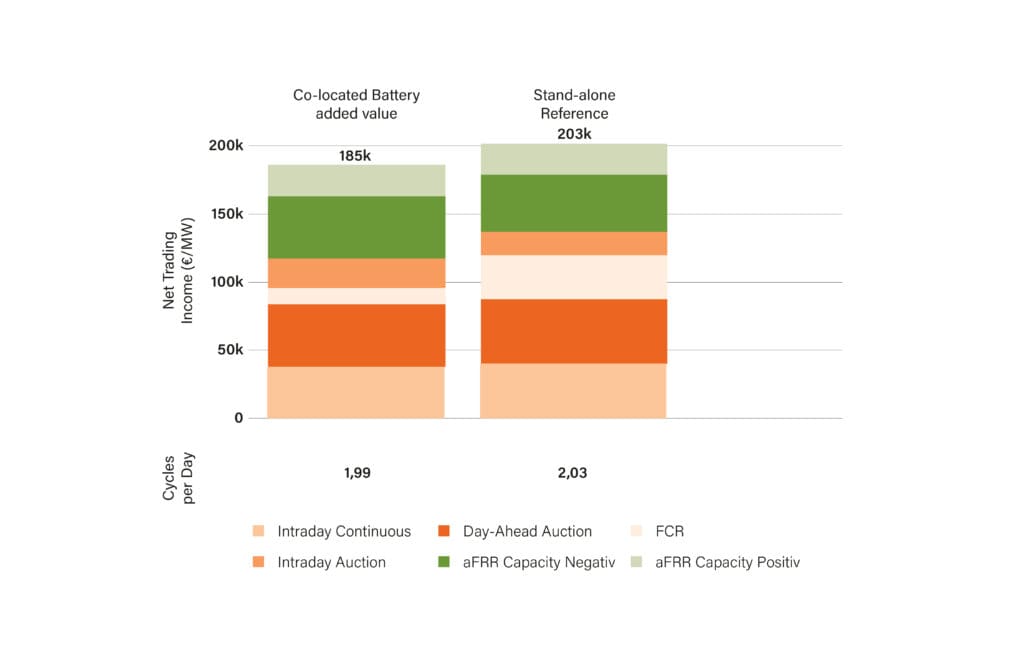The future of wind energy: Efficient energy storage for wind turbines
Over the past few decades, wind energy has become one of the most significant renewable energy sources. Despite its potential, a major challenge remains: balancing energy production with consumption and, consequently, energy storage. This article explores innovative solutions that enable wind turbines to store energy more efficiently.


- 8 Min.
Advancements in lithium-ion battery technology and the development of advanced storage systems have opened new possibilities for integrating wind power with storage solutions. This article highlights how these new technologies can enhance the efficiency of wind energy utilization and ensure its availability when needed.
Additionally, we examine regulatory frameworks, challenges, solutions, and benefits associated with energy storage in wind power applications. Read on to discover how efficient energy storage can revolutionize wind energy and support the energy transition.
Introduction to wind energy and its role in renewable energy production
Wind energy is among the fastest-growing renewable energy sources worldwide. Technological advancements over recent decades have significantly improved the efficiency and performance of wind turbines. By harnessing the kinetic energy of the wind to generate electricity, wind energy offers an eco-friendly alternative to fossil fuels. This form of energy production not only reduces greenhouse gas emissions but also decreases dependence on non-renewable resources.
The importance of wind energy is underscored by its ability to produce sustainable energy on a large scale. Many countries rely on wind power to achieve climate goals and drive the energy transition. Especially in Europe, where numerous offshore and onshore wind farms are operational, the potential of this technology is evident. Wind energy has the capacity to meet a significant portion of global electricity demand, with studies predicting it will play a key role in the global energy economy in the coming decades.
However, wind energy faces challenges, particularly regarding the storage of generated electricity. Since wind conditions are not constant, it is crucial to develop hybrid power plants that combine wind energy with storage systems. These technologies allow wind turbines to be directly coupled with energy storage systems, efficiently storing excess wind power for later use. Without advancements in energy storage, the full potential of wind energy cannot be realized, limiting its role in future energy supply.
The use of energy storage systems for wind turbines
Efficient energy storage systems are vital for the future of wind energy as they help address several key challenges. Currently, there are four primary drivers where combining wind turbines with energy storage systems is beneficial:
- Energy Storage Instead of Wind Turbine in Repowering Projects
Repowering involves dismantling old wind turbines and constructing new ones nearby. If regulatory constraints prevent new turbine installations at the same site, an energy storage system can be a viable alternative. This approach leverages the existing infrastructure, reducing costs and optimizing the site. - Optimizing Existing Sites
Adding an energy storage system to an existing wind turbine allows the use of current grid connections for dual business models, enhancing site profitability and diversification. Typically, wind turbines and energy storage systems are optimized independently in separate market locations. Economically, the differences between standalone storage systems and co-located systems are minimal, with studies showing revenue impacts of no more than 15% due to occasional grid connection overlaps. - Reactive Power Provision
Reactive power is essential for grid stability. Wind turbines often cannot supply the required reactive power, necessitating compensatory systems. Energy storage systems can fulfill this role by oversizing the inverter or using it as a STATCOM (Static Synchronous Compensator), making the overall investment more cost-effective for customers. - Energy Storage with Wind Turbines in Repowering Projects
When modernizing wind turbines through repowering, combining them with energy storage systems offers portfolio optimization and asset diversification in the energy market. As described in site optimization, storage systems can be operated as an additional business model alongside wind turbines.
The importance of the renewable energy act
The German Renewable Energy Act (EEG) remains the foundation for promoting wind energy. The EEG exclusivity principle states that a facility is eligible for subsidies only if it feeds exclusively renewable energy into the grid. This has implications for integrating battery storage systems:
- Wind turbines can still receive EEG subsidies if operated separately from the battery storage system.
Under the current EEG, wind turbines remain an attractive business model. Operating turbines outside the EEG to enable hybrid operations with storage systems is generally not advisable. However, separate operation in different market locations ensures compliance with the exclusivity principle while optimizing site usage. This approach allows infrastructure costs to be shared between both business models, with wind turbines earning subsidies under the EEG and storage systems generating revenue through flexible multi-market optimization.
A detailed analysis is required for optimal storage dimensioning and the best possible utilization of the economic potential of both systems. Our experts will be happy to advise you. Make an appointment now!
If you are planning your energy storage project, please contact us.
Key considerations for energy storage systems
Significant advancements in energy storage technologies have been made in recent years. Lithium-ion batteries are among the most commonly used technologies due to their high energy density and long lifespan. These batteries are ideal for energy storage as they respond quickly to charging and discharging demands, making them suitable for many wind energy projects.
When selecting the right energy storage system for a wind turbine, several factors should be considered:
- Storage Size: It is generally recommended to match the storage system size with the wind turbine’s capacity.
- Two-Hour Systems: A common recommendation is to use two-hour systems, referring to the time required to fully discharge the stored energy at the system’s rated power. For example, a 6 MWh battery with a two-hour discharge rate has a rated power of 3 MW, meaning it can deliver 3 MW continuously for two hours until depleted.
Challenges and solutions in using energy storage for wind turbines
- Grid Connection Point Utilization: The grid connection may be intermittently occupied by the wind turbine, limiting the storage system’s ability to feed power into the grid. However, this has minimal revenue impact, as studies show these effects are generally insignificant.
- Price Volatility: Electricity prices do not always correlate with wind power generation. Energy storage systems can capitalize on price fluctuations, profiting from peak prices or providing grid balancing services.
Innovation projects and research in wind energy storage
Various innovation projects and research initiatives aim to improve wind energy storage and develop new technologies. Universities, research institutes, and companies worldwide collaborate to address energy storage challenges and enhance the efficiency and cost-effectiveness of wind power systems.
Projects like the “Wind+Storage Combination” in Uckermark demonstrate how such integrations can be supported through innovation tenders, promoting the synergy between wind energy and storage systems. Research focuses on developing efficient, cost-effective storage technologies to store excess wind power and release it when needed. These advancements are crucial for reducing dependence on fossil fuels and ensuring a sustainable energy future.
The role of governments and authorities in promoting efficient energy storage
Wind turbine and battery storage operators must comply with various governmental and regulatory requirements:
- Accurate measurement and allocation of electricity volumes per § 62b EEG 2021.
- Annual reporting obligations for consumed and delivered electricity.
- Non-compliance may result in sanctions, such as the loss of self-consumption privileges or increased EEG surcharges.
Governments and authorities play a critical role in supporting the development and implementation of efficient energy storage for wind turbines. Through policies, funding programs, and financial incentives, they can foster research, encourage new technologies, and improve market conditions for innovative storage solutions. This support is essential for addressing energy storage challenges and integrating renewable energy into existing energy systems.
Benefits of using energy storage for wind energy systems
The economic aspects of efficient energy storage in wind power systems are key to their long-term profitability and competitiveness. Benefits include:
- Mitigating Negative Electricity Prices: Store energy during low or negative price periods and sell during high-price periods (applicable if the wind turbine operates outside EEG support).
- Providing Grid Balancing Services: Participate in ancillary service markets to support grid stability.
- Optimizing Market Revenues: Targeted energy dispatch during high-price periods.
- Grid Stability and Energy Security: The combination of wind turbines and storage systems enhances grid stability and ensures a reliable renewable power supply, even during low-wind periods.
- Optimized Infrastructure Use: Wind turbines and energy storage systems can share the same infrastructure and grid connection, enabling cost efficiencies through synergies.
- Regulation Services and Ancillary Benefits: Energy storage systems can provide grid regulation services and innovative ancillary services, such as frequency stabilization.
- Reducing Curtailments: Coupling wind turbines with storage systems minimizes curtailment during grid congestion, optimizing energy delivery.
- Alternative Business Models Post-EEG Support: Hybrid solutions with energy storage offer new market models for wind farm operators after EEG subsidies expire.
Profitability calculation
The operation of an energy storage system with a wind turbine offers economic advantages, as shown in the following figures. Depicted are two V112 turbines from the Paderborn district. The grid connection point in this example has a capacity of 7 MW, which corresponds to the size of the two installed wind turbines.
In the following figure, the revenues of a wind turbine for the year 2023 are displayed. The figure clearly shows declining revenues during the summer months.

In the next figure, the revenues of the energy storage system at the grid connection point of the wind turbine are shown. These are the revenues generated solely through multi-market optimization, in addition to the revenues from the wind energy asset (WEA). Here, the increasing revenues during the summer months are particularly noticeable.

The combined revenues highlight the economic growth achieved through the operation of both systems. Thus, the energy storage system can offset the declining revenues of the wind turbine in the summer.

Compared to standalone storage systems, i.e., separate operation, there are only minor deductions in colocation, i.e., combined operation. This difference arises from the partial occupation of the grid connection point by the wind turbine.

Conclusion: The future of wind energy and the role of efficient energy storage systems
The future of wind energy is promising, especially with continuous advancements in technology and the development of efficient energy storage systems. However, to fully realize the potential of wind power, it is essential to develop innovative energy storage solutions. Efficient energy storage systems will be crucial to address the challenges of intermittent energy generation and to ensure a stable, reliable power supply.
The combination of advanced wind technology and high-performance storage systems can significantly enhance the profitability of wind turbines and facilitate the integration of renewable energy into existing energy systems. Governments, companies, and research institutions play a key role by promoting the development and implementation of new technologies and improving the economic framework conditions.
Overall, wind energy, supported by efficient energy storage systems, will make a significant contribution to the global energy transition. By maximizing the potential of this sustainable energy source, we can create a more environmentally friendly and economically sustainable energy future. Achieving this goal will require commitment, innovation, and collaboration at both national and international levels.
Do you have further questions?
Then book a free online consultation with one of our experts for your energy storage system.

